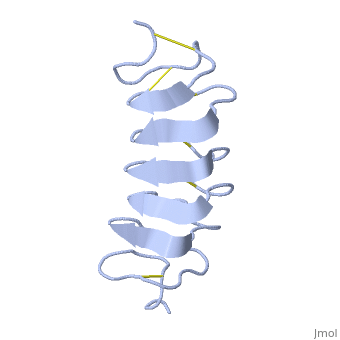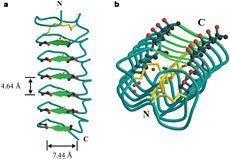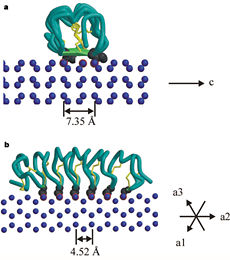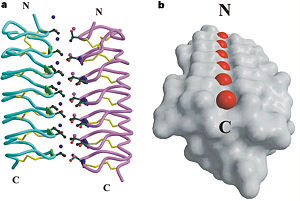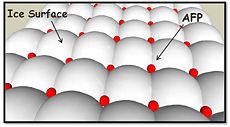Tenebrio molitor Antifreeze Protein (TmAFP)
From Proteopedia
(Difference between revisions)
| Line 7: | Line 7: | ||
AFPs are classified into two groups on the basis of their activity (Thermal Hysteresis or TH, see below in Function), moderate and hyperactive AFPs. | AFPs are classified into two groups on the basis of their activity (Thermal Hysteresis or TH, see below in Function), moderate and hyperactive AFPs. | ||
Moderate AFP's usually originate from fish that live in the polar area in which the water temperature can be low as -2 degrees Celsius . | Moderate AFP's usually originate from fish that live in the polar area in which the water temperature can be low as -2 degrees Celsius . | ||
| - | Hyperactive AFP usually originate from insects (but recently have been discovered in other organisms including bacteria) that live in areas where the temperature is much lower and can be as low as -40 | + | Hyperactive AFP usually originate from insects (but recently have been discovered in other organisms including bacteria) that live in areas where the temperature is much lower and can be as low as -40 degrees Celsius. |
.<ref>DOI doi:10.1016/j.cryobiol.2006.06.006</ref> | .<ref>DOI doi:10.1016/j.cryobiol.2006.06.006</ref> | ||
| Line 55: | Line 55: | ||
== The difference between TmAFP (hyperactive AFP) and Type I AFP (moderate AFP) == | == The difference between TmAFP (hyperactive AFP) and Type I AFP (moderate AFP) == | ||
| - | TmAFP has a special structure of a short very regular beta helix, which yields a binding site consisting of a two dimensional surface: <scene name='61/612804/Thr/3'>two arrays of Thr residues</scene> that can bind to the two planes of ice i.e. prism plane and basal plane. This is why the TH activity can reach 6 | + | TmAFP has a special structure of a short very regular beta helix, which yields a binding site consisting of a two dimensional surface: <scene name='61/612804/Thr/3'>two arrays of Thr residues</scene> that can bind to the two planes of ice i.e. prism plane and basal plane. This is why the TH activity can reach 6 degrees Celsius in Hyperactive protein. |
| - | In contrast <scene name='61/612804/Afp1/1'>Type I AFP</scene>, from the fish winter flounder (moderate AFP are usually fish origin), structure is alpha helix allows just one dimensional surface of | + | In contrast <scene name='61/612804/Afp1/1'>Type I AFP</scene>, from the fish winter flounder (moderate AFP are usually fish origin), structure is alpha helix allows just one dimensional surface of Thr residue and thus can bind only to one plane of ice (the prism plan). Because of that The TH activity is much lower, maximum TH activity of moderate AFP is 1 degree Celsius. |
[[Antifreeze protein]] | [[Antifreeze protein]] | ||
Revision as of 16:15, 25 January 2015
| |||||||||||
References
- ↑ Scotter AJ, Marshall CB, Graham LA, Gilbert JA, Garnham CP, Davies PL. The basis for hyperactivity of antifreeze proteins. Cryobiology. 2006 Oct;53(2):229-39. Epub 2006 Aug 2. PMID:16887111 doi:http://dx.doi.org/10.1016/j.cryobiol.2006.06.006
- ↑ Liu K, Jia Z, Chen G, Tung C, Liu R. Systematic size study of an insect antifreeze protein and its interaction with ice. Biophys J. 2005 Feb;88(2):953-8. PMID:15713600 doi:http://dx.doi.org/10.1529/biophysj.104.051169
- ↑ 3.0 3.1 Liou YC, Tocilj A, Davies PL, Jia Z. Mimicry of ice structure by surface hydroxyls and water of a beta-helix antifreeze protein. Nature. 2000 Jul 20;406(6793):322-4. PMID:10917536 doi:10.1038/35018604
- ↑ doi: https://dx.doi.org/10.1016/S0968-0004(01)02028-X
